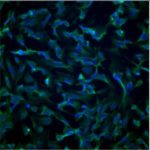Link to Pubmed [PMID] – 11772035
Biochemistry 2002 Jan;41(1):357-66
DNA triple helices offer exciting perspectives toward oligonucleotide-directed control of gene expression. Oligonucleotide analogues are routinely used with modifications in either the backbone or the bases to form more stable triple-helical structures or to prevent their degradation in cells. In this article, different chemical modifications are tested in a model system, which sets up a competition between the purine and pyrimidine motifs. For most modifications, the DeltaH degrees of purine triplex formation is close to zero, implying a nearly temperature-independent affinity constant. In contrast, the pyrimidine triplex is strongly favored at lower temperatures. The stabilization induced by modifications previously known to be favorable to the pyrimidine motif was quantified. Interestingly, modifications favorable to the GT motif (propynyl-U and dU replacing T) were also discovered. In a system where two third strands compete for triplex formation, replacement of the GA or GT strand by a pyrimidine strand may be observed at neutral pH upon lowering the temperature. This purine-to-pyrimidine triplex conversion depends on the chemical nature of the triplex-forming strands and the stability of the corresponding triplexes.

